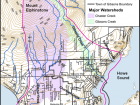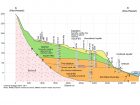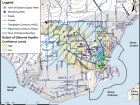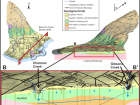
Features
Sustainability
Water Issues
Gibsons aquifer update
B.C. town’s approach to natural-asset management is catching on
March 2, 2017 By Carolyn Camilleri
The residents of the Town of Gibsons, B.C., are very proud of their aquifer. In 2005, the town’s fresh, clean, untreated drinking water won the title “Best-Tasting Water in the World” from the Berkeley Springs International Water Tasting competition.
Then from 2009 to 2013, an exhaustive mapping study of the aquifer was completed. In addition to providing the town’s engineering and planning departments with an accurate picture of the aquifer and the threats to it, the study brought public education and awareness to a whole new level. Terms like aquifer, aquitard and even ground water may not be common in most Canadian communities, but in Gibsons they are part of the local lingo.
So when The George – a waterfront hotel-condominium-marina project – was proposed, developers were up against more than just town council. A heated controversy that ensued over the project’s potential impact on the aquifer stalled work for over two years. (See “Water Aware: Controversial proposal increases aquifer awareness.”)
In 2015, the aquifer mapping study led to another significant step forward: Aquifer Protection Development Permit Area No. 9 (DPA 9).
DPA 9 is located over Gibsons aquifer and the ground water system that supplies potable water to approximately 73 per cent of Gibsons’ residents and sustains habitats as a base flow or discharge to surface water sources, including several area creeks. To avoid contamination of the aquifer and penetration of the aquitard confining it, permits must be obtained for any activity involving construction, excavation, surface drainage, and the storage, handling, manufacture, and use of products on land within DPA 9. Strict guidelines outline the permit-application process, and applications are reviewed by the same hydrogeology firm that completed the aquifer-mapping study.
“We have set very high standards for construction in the aquifer-vulnerable areas,” says Dave Newman, director of engineering for the Town of Gibsons. “As far as any development application is concerned, the overarching position of the town is that we are not prepared to compromise the health and integrity of the Gibsons aquifer – full stop.”
Newman says there have been several opportunities to apply DPA 9 since it was implemented, and it has been a good education process for developers and the town. But legislation to protect the aquifer hasn’t stopped there. Gibsons is also leading the charge when it comes to thinking differently about asset management.
Most communities in Canada are involved in managing engineered assets – infrastructure such as roads, water, waste water and storm water – and have shifted to a systematic business process for making strategic and operational decisions about municipal assets over their entire life cycle rather than merely maintaining assets.
“The emphasis of asset management is on a process for operating infrastructure throughout its full life cycle in the most sustainable and cost-effective manner,” Newman says. “In Gibsons, we are using these same principles for managing our natural assets.”
“Towards an Eco-Asset Strategy in the Town of Gibsons”* outlines the plans and objectives for the long-term management of assets, including the aquifer, which filters and stores the town’s drinking water, and the creeks, which convey storm water.
“A key component of natural-asset management is that with proper operations and maintenance practices with appropriate environmental consideration, a given natural asset can be used in perpetuity with no replacement cost, which is a costly component of engineered assets,” Newman says.
The strategy lists four objectives:
1. Managing risk by ensuring that Gibsons has a clear understanding of what services they receive from natural assets, such as flood prevention, provision of drinking water, and rainwater management, and what it would cost to replace the natural asset with an engineered alternative if the assets were degraded or destroyed
2. Saving costs by managing natural assets in a way that they will provide services at lower cost and in perpetuity
3. Maintaining healthy ecosystems as a result of sound asset-management strategies
4. Managing the asset to provide services for future development without degrading the condition
Support for these measures – both the DPA 9 and the eco-asset management strategy – has been solid. And it’s not just a staff initiative, Newman says. “The town council is very much on board with the concept of natural assets and the idea of integrating it into our asset-management plans.”
“It means we have money set aside for the care of creeks and monitoring of our aquifer without it being on the chopping block of a capital project,” he says. “It’s integrated into our operations and maintenance plans, and it becomes commonplace that we are taking care of our natural assets as much as, if not more than, we are our engineered assets.”
Moreover, thus far, there hasn’t been any pushback or opposition from the public or developers.
“My impression is that there’s an appreciation of the stakes that we’re playing with,” Newman says. “This is our drinking water supply and it’s untreated. People seem to be able to embrace that. It seems to be something that people are receptive to.”
Gibsons has become something of a model for other communities with natural assets. While some concerns for protecting an aquifer may be unique to Gibsons – for example, proximity to the ocean or the thinning of the layer protecting the confined aquifer in some places – drinking water contamination is a common community concern.
In 2016 alone, Town of Gibsons staff and council have made 34 presentations on the topic, including at major global conferences (GLOBE and World Forum on Natural Capital), workshops and webinars. From Halifax to the Yukon, the Gibsons model has been presented to politicians, health authorities, academics, engineering professionals, senior associations, environmental organizations and business groups.
“One of the big pros of this is that it becomes a meeting of the minds, so to speak. You can have the people on one end that don’t want any development and want to save all the trees and keep things 100 per cent in their natural state, and then you’ve got the developers that are developing because it’s a business and it’s their livelihood,” Newman says. “Promoting the natural assets and coming up with solutions that enhance and take care of our natural assets, and use those to provide municipal service and care for them, so that they can continue to do that is something that everyone can buy into.”
It is important to note that none of these great strides forward would have been fully possible without the mapping study that was done under contract by Waterline Resources Inc., a hydrogeological and environmental consulting firm with offices in Calgary and Nanaimo, B.C.
“As with any asset, in order to manage it, you need to know what you’ve got. That mapping study certainly did that for us. It identified our vulnerabilities. Without one, you’d be flying a little bit blind,” Newman says. “I’m not saying you couldn’t do it, but it would be challenging.”
While managing natural and engineered assets together has become commonplace in Gibsons, it is starting to catch on elsewhere.
“There are a lot of big players in asset management that are embracing this concept,” Newman says. “I envision it becoming very mainstream in the not-too-distant future.”
After all, when you think about it, it just makes sense.
*The document Towards an Eco-Asset Strategy in the Town of Gibsons is available for review at www.gibsons.ca/eco-assets
Carolyn Camilleri is a Toronto-based writer, editor, and content strategist. She has been writing for consumer and trade magazines, as well as businesses and organizations across the country, for more than 15 years.
Ground Water Awareness Week in Canada is made possible in part through the support of the Ontario Media Development Corporation (OMDC).
Print this page




